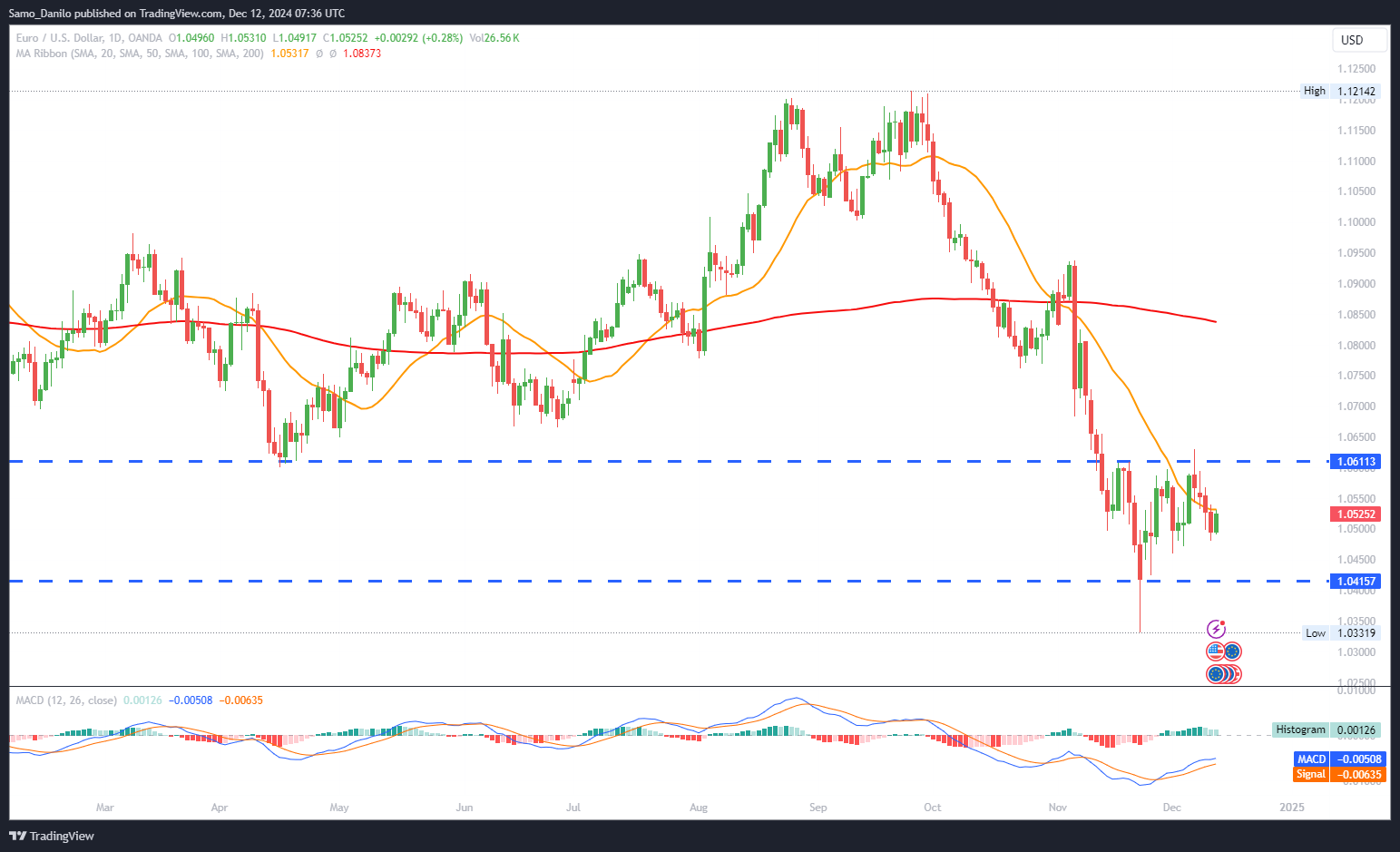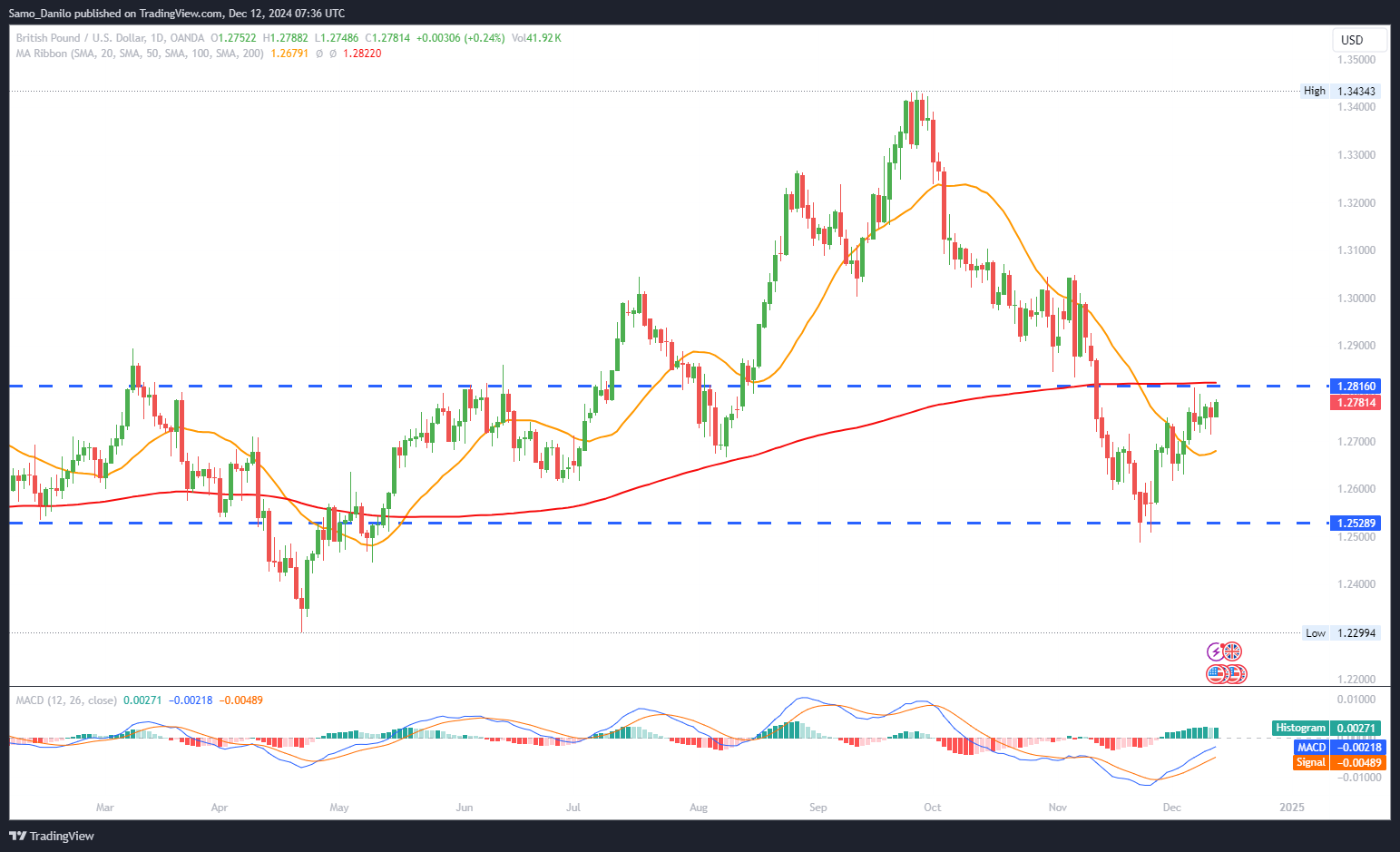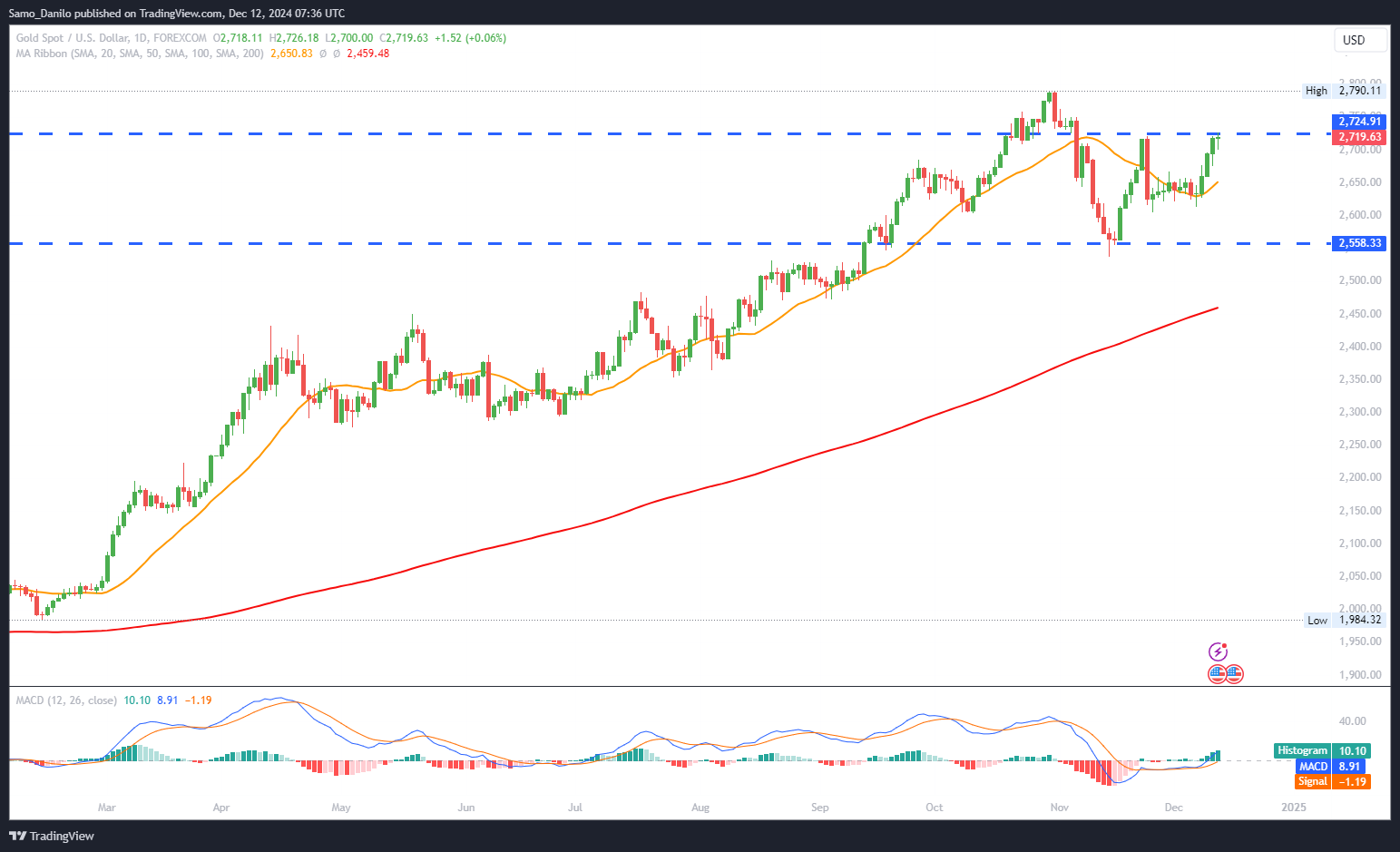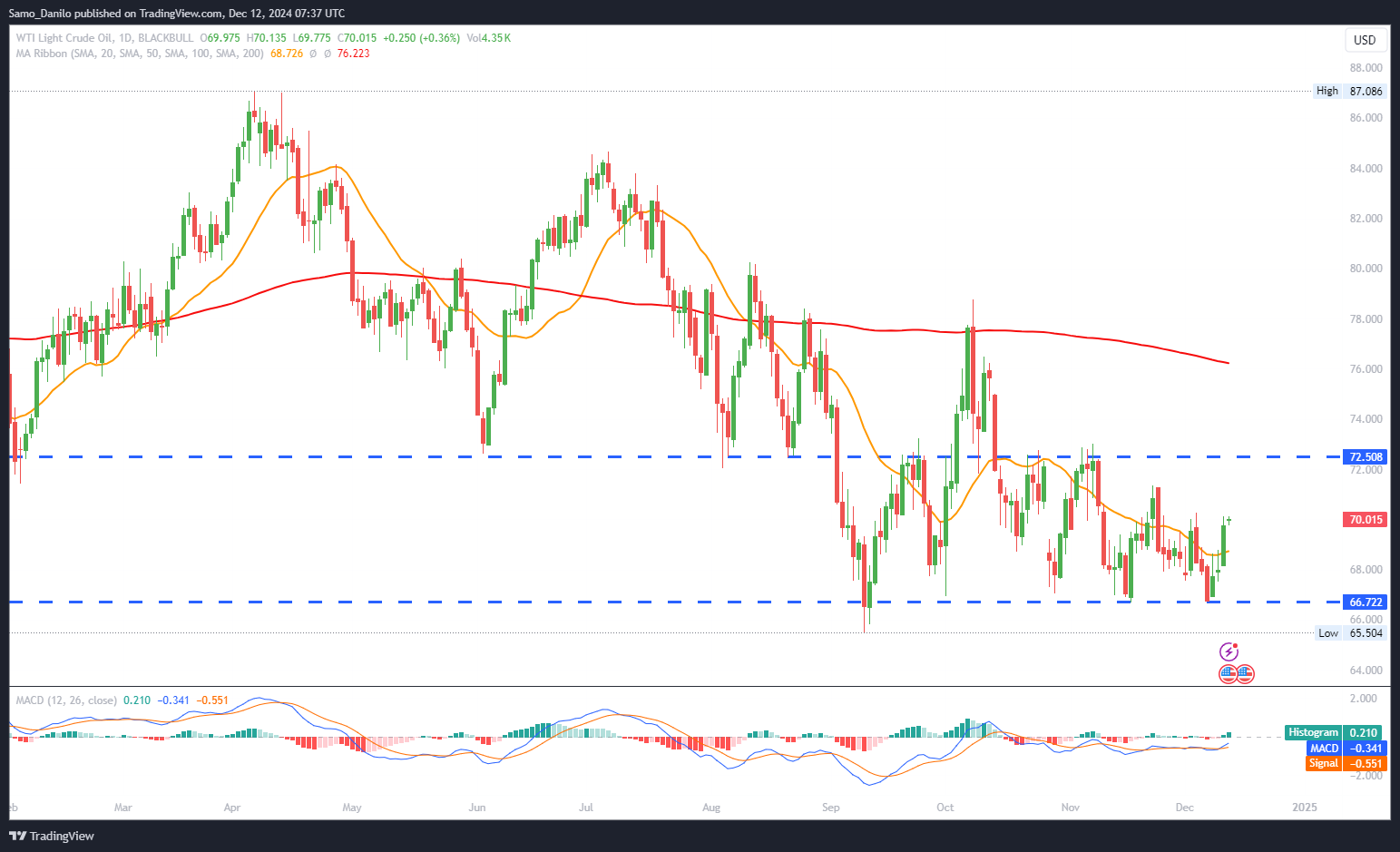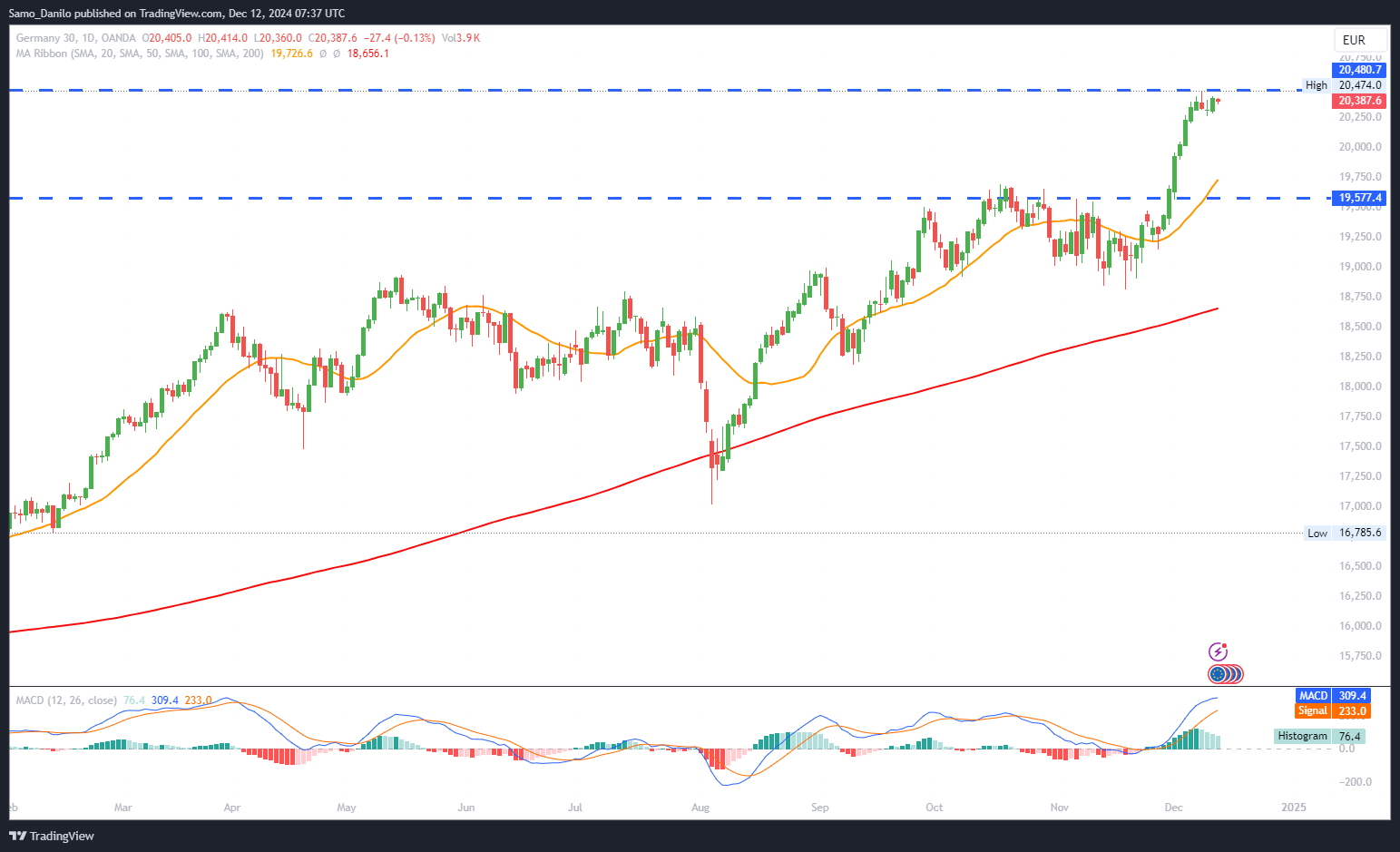EURUSD
- EUR/USD Price: The EUR/USD pair holds its ground near 1.0500 during the European session on Thursday, supported by a broad retreat in the US Dollar. Market optimism surrounding today’s European Central Bank (ECB) rate decision adds to the pair’s positive bias.
- ECB Rate Cut: The ECB is widely expected to lower interest rates at its meeting today, reflecting worries about the faltering Eurozone economy. However, uncertainty persists regarding the size of the cut, with some investors speculating a larger reduction may be on the table.
- ECB Policy Statement: Traders will closely scrutinize the ECB’s monetary policy statement and ECB President Christine Lagarde’s remarks at the post-meeting press conference. Markets are eager for insights into future rate cuts and the central bank’s outlook on economic recovery in the Eurozone.
- US CPI Inflation: US headline CPI inflation ticked up slightly to 2.7% YoY in November from 2.6%, while core inflation remained steady at 3.3%. These figures provide a mixed backdrop for the Federal Reserve, keeping traders alert to the potential impact on monetary policy.
- US Data: Besides the ECB decision, traders will monitor US macroeconomic data, including the Producer Price Index (PPI) and Weekly Initial Jobless Claims. These indicators may offer further clues on the health of the US economy and influence the EUR/USD pair’s movement.
Closing statement: The EUR/USD pair’s trajectory hinges on the outcome of the ECB meeting and President Lagarde’s tone regarding future rate decisions. While US macro data could introduce volatility, the pair’s near-term direction will likely depend on whether the ECB signals a more aggressive approach to counteract Eurozone economic challenges.
GBPUSD
- GBP/USD Price: GBP/USD rebounded during the European morning on Thursday, trading closer to the 1.2800 mark as the US Dollar softens. The pair's recovery reflects improved market sentiment and a technical bounce.
- UK Housing Market: The RICS Housing Price Balance for November surged by 25%, significantly exceeding the market forecast of a 19% increase and improving on October’s 16% rise. This data signals robust activity in the UK housing market, contributing to the Pound's strength.
- BoE’s Policy: Rising market confidence that the Bank of England (BoE) will maintain its interest rate at 4.75% in December bolsters the Pound. Expectations of a pause in rate changes reflect the BoE's cautious approach to balancing economic risks.
- US Dollar: The US Dollar’s correction provides additional support for GBP/USD, enhancing the pair’s upside momentum. Dollar movements remain tied to expectations surrounding US inflation trends and the Federal Reserve's monetary policy outlook.
- Upcoming Data: Investors are eyeing the UK’s October GDP figures, due on Friday, for further insights into the economy’s performance. Meanwhile, US PPI inflation, released on Thursday, aligns with the week’s CPI trends, with producer-level inflation expected to tick higher.
Closing statement: GBP/USD's recovery momentum hinges on upcoming data releases, particularly the UK GDP and US PPI figures. Positive UK data could reinforce market confidence in the British economy and sustain the pair’s bullish trajectory toward 1.2800, while Dollar-driven volatility may shape near-term price action.
XAUUSD
- Gold Price: Gold prices remain below their one-month high, touched earlier on Thursday, following a modest correction. The yellow metal continues to consolidate gains amid cautious trading.
- Fed Rate Cut: US consumer inflation data released Wednesday reinforced expectations of a third consecutive rate cut by the Federal Reserve next week. Lower interest rates generally boost the appeal of non-yielding assets like gold.
- US Budget Deficit: The US government posted a $367 billion budget deficit in November, a 17% year-over-year increase. This fiscal imbalance highlights economic vulnerabilities, indirectly supporting gold as a hedge against uncertainty.
- Geopolitical and Monetary Factors: Uncertainty in Syria, optimism surrounding China’s stimulus, and the People’s Bank of China’s (PBOC) continued gold purchases lend additional support to bullion. These factors underscore gold's role as a safe-haven asset amid global economic and political turbulence.
- US Data: Market participants are closely monitoring Thursday’s US Producer Price Index (PPI) and weekly Jobless Claims data for clues about the Federal Reserve’s policy direction. Any dovish signals could weaken the USD further and provide tailwinds for gold prices.
Closing statement: Gold prices are poised to remain supported ahead of the Federal Reserve meeting next week. Continued geopolitical uncertainties, fiscal concerns, and dovish US monetary policy expectations position gold as a preferred safe-haven asset. However, near-term price movements will depend on key economic data and USD fluctuations.
CRUDE OIL
- WTI Oil Prices: West Texas Intermediate (WTI) Crude Oil surged by approximately 2.75% on Wednesday, breaking above the $70 per barrel mark. This marks a significant rebound, driven by improved demand prospects and supply-related factors.
- EIA Data: The Energy Information Administration (EIA) reported a drop in US crude oil inventories by 1.425 million barrels for the week ending December 6. The decline exceeded forecasts (-1.1 million barrels), following the prior week’s substantial drawdown of over 5 million barrels, signaling tighter supply conditions.
- OPEC Forecasts: OPEC revised its global crude oil demand growth projections downward for 2024, aligning closer to the more conservative estimates provided by the EIA. This adjustment underscores potential headwinds for long-term oil demand.
- Geopolitical Risks: The Biden administration is reportedly considering stricter sanctions on Russian oil, further pressuring global supply. Additionally, the European Union's new sanctions package against Russia, announced Wednesday, could exacerbate supply tightness and act as a tailwind for oil prices.
- Russia-Ukraine War: Escalating geopolitical tensions stemming from Russia’s ongoing war in Ukraine continue to support a geopolitical risk premium. Market sentiment suggests that stricter sanctions and limited Russian exports may tighten global crude availability in the coming months.
Closing statement: WTI Crude Oil prices appear poised for further gains amid tightening supply dynamics, geopolitical risks, and robust near-term demand. However, revised global demand growth expectations by OPEC and economic uncertainties may limit the scope of sustained upward momentum. Key factors such as sanctions developments and inventory trends will remain in focus.
DAX
- DAX Price: On Wednesday, the DAX rose by 0.34%, recovering from Tuesday’s 0.08% decline. However, the index remains below the all-time high of 20,462, set earlier this week on Monday, December 9.
- Defense Stocks: Defense stocks bolstered the DAX on Wednesday, with Rheinmetall AG advancing 2.21% and MTU Aero increasing 1.06%. Investor sentiment was influenced by reports of heightened military activity by Ukraine targeting Russia, raising interest in defense-related equities.
- ECB Rate Decision: On Thursday, the European Central Bank (ECB) is expected to announce a 25-basis point rate cut. Market participants are closely monitoring the decision, which could influence sectors sensitive to interest rate changes, such as financials and real estate.
- US CPI Data: November’s US CPI data reinforced expectations of a December Fed rate cut. Headline inflation rose to 2.7% year-on-year, with core inflation holding steady at 3.3%. These results aligned with market expectations, driving demand for riskier assets and indirectly supporting European equities.
- US Economic Data: Investors will closely watch Thursday’s US producer price index (PPI) and jobless claims data. The PPI is regarded as a leading indicator of inflation and could impact risk sentiment, with potential spillover effects on DAX performance.
Closing statement: The DAX shows resilience but remains below its record high, with defense stocks playing a key role in midweek gains. Upcoming ECB and US economic data will be critical in shaping investor sentiment. A dovish ECB stance combined with a stable US inflation outlook may further support the DAX in the near term.
